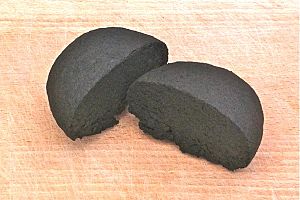Leaf protein concentrate facts for kids

Leaf protein concentrate (LPC) is a special type of protein. It is made by taking the proteins from plant leaves and making them more concentrated. Think of it like squeezing all the good stuff out of leaves!
Scientists have looked at LPC as a possible food for people and animals. This is because it could be a very cheap and easy-to-find source of protein. Even though we can get some protein from eating leafy vegetables, our bodies can't digest the huge amount of leaves needed to get all the protein we need. That's where LPC comes in handy.
Contents
What is Leaf Protein Concentrate Made Of?
Whole leaf protein concentrate is a dark green substance. It feels a bit like cheese. About 60% of it is water. The rest is dry material. This dry part contains 9-11% nitrogen, 20-25% fat, and 5-10% starch. It also has some ash. LPC is actually a mix of many different proteins. Some people say it tastes like spinach or tea.
Sometimes, the color and taste of whole LPC might not be appealing for people. So, it can be separated into two parts: a green part and a white part. The green part has proteins mostly from the chloroplasts. These are the parts of the plant that make food using sunlight. The white part has proteins mostly from the cytoplasm. This is the jelly-like substance inside plant cells.
How is Leaf Protein Concentrate Used?
LPC was first thought of as a human food a long time ago, in the early 1900s. It showed a lot of promise back then. However, it hasn't become a very common food for people.
A famous scientist from the UK, Norman Pirie, studied LPC a lot. He believed it could help feed people. He and his team even built special machines to get LPC from leaves. Some of these were small "village units." They were made for poor rural communities. These machines were set up in places like villages in southern India.
Today, many animals are raised in feedlots to provide meat for people. This means there's a big need for cheaper plant-based protein for animal feed. Because of this, people are becoming interested in LPC again. It can help reduce how much human-edible plant protein is used to feed animals.
LPC has been successfully tested as a replacement for soy in feed for chickens and pigs. It can also be added to feed for tilapia fish. This helps to replace some of the fish meal they usually eat.
How Nutritious is Leaf Protein Concentrate?
Leaf protein is a good source of amino acids. These are the building blocks of protein. One amino acid called methionine is sometimes a bit low in LPC. Overall, LPC is more nutritious than proteins from seeds. It is also similar to proteins from animals, except for those found in eggs and milk.
When we talk about how well our bodies can use the protein, we call it "digestibility." Whole LPC can be digested very well, from 65% to 90%. The green part of LPC is not digested as well, sometimes less than 50%. But the white part is digested very well, often more than 90%.
Some plants used for LPC, like lucerne and cassava, have a lot of fiber. They can also have things called "antinutritional factors." These are natural substances that can make it harder for our bodies to use the nutrients. Examples include phytate, cyanide, and tannins. Scientists work to overcome these challenges.
Other plants that can be used to make LPC include Lablab beans, Moringa oleifera, tree collards, and bush clover. The taste of LPC can be very different depending on the plant it comes from.
How is Leaf Protein Concentrate Made?
Making LPC generally involves a few steps:
- First, the leaves are crushed into a pulp.
- Then, the juice is pressed out of the pulp.
- Next, the juice is heated. This makes the protein clump together, or "coagulate."
- Finally, the protein clumps are filtered out and dried.
To get the green and white parts of the protein separately, a two-step heating method is often used. First, the juice is heated to about 60 °C. This makes the green protein clump together. Then, it's heated to about 80 °C. This makes the white protein clump together. Other ways to make LPC have also been suggested. These include using special chemicals called polyelectrolytes, or using very fast spinning machines like ultracentrifugation.

